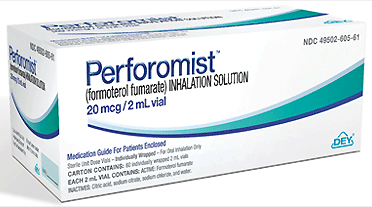Product
Perforomist
Approval Date
May 11, 2007
Release Date
September 25, 2007
Company
Dey, L.P.
Class
Long acting ß2-agonist
Indication
Long-term maintenance treatment of COPD-associatedbronchoconstriction.
Active Ingredient
Formoterol (as fumarate) 20mcg/2mL; soln for inh.
Agency Roster
Wishbone ITP (DTC, DTP and professional)
Feinstein Kean Healthcare (PR)
MarketingStrategy/Execution
Perforomist will be co-marketed by the sales forces of Mylansubsidiary Dey Labs and by marketing partner Critical Therapeutics. With thesame active ingredient as a previouslyapproved dry powder formulation, Perforomist is the first nebulizedversion of the LABA formoterol fumarate, a 10-year-old molecule marketed by Novartisas Foradil. Dey has a track record in the respiratory space and will bepromoting Performist to a familiar physician base, clinicians involed in pulmonarymedicine such as pulmonologists, hospital-based doctors and some PCPs. The onlyother nebulized LABA is Sepracor’s Brovana, also launched this year. WishboneITP will be developing physician detailing pieces, as well as DTC and DTPmaterial.
The Market
| Beta agonists US sales ($000s) last 5 years | |
| 2006 |
$1,597,804 |
| 2005 |
$1,355,168 |
| 2004 |
$1,268,521 |
| 2003 |
$1,332,841 |
| 2002 |
$1,383,551 |
| Source: IMS Health, Oct. 2007 |
|
| Top 5 beta agonists | ||
| Jan.-July ’07 US sales ($000s) | % sales growth over Jan.-July ‘06 | |
|
XOPENEX (Sepracor) |
354,557 |
7 |
|
PROAIR HFA (Teva) |
218,729 |
761 |
|
PROVENTIL HFA (Schering-Plough) |
104,166 |
262 |
|
SEREVENT DISKUS (GSK) |
84,378 |
-14 |
|
ALBUTEROL |
82,705 |
809 |
| Source: IMS Health, Oct. 2007 |
||
Also in the Pipeline(according to Adis R&D Insight)
Drug: Alenia
Manufacturer:AstraZeneca
Indication: COPD
Active Ingredient: Budesonide/formoterol
Phase: III
Drug: Serevent
Manufacturer: GlaxoSmithKline
Indication: Asthma, COPD
Active Ingredient: Salmeterol
Phase: III
Source: Wolters Kluwer Health, Oct. 2007
Recent MM&MCoverage
ProductNews from the 05/15/07 news brief
Pharmacology
Perforomist is a solution formulation of the long-acting ß2-agonist,formoterol fumarate, which is administered by inhalation via nebulization. Itacts as a bronchodilator by stimulating ß2 receptors in the lung.However, it may have cardiac effects due to the presence of ß2receptors in the heart. The activity of formoterol and related drugs are due inpart to the stimulation of intracellular adenyl cyclase, the enzyme thatcatalyzes the conversion of ATP to cyclic AMP. This in turn causes increases inthe levels of cyclic AMP, which causes the relaxation of bronchial smoothmuscle along with anti-inflammatory effects.
Clinical Trials
A 12-week, randomized, double-blind, placebo- andactive-controlled study was conducted to assess the efficacy of Perforomist intreating adults diagnosed with COPD-associated bronchoconstriction. Perforomist20mcg twice daily resulted in significantly greater post-dose bronchodilation,compared to a placebo, at endpoint. Patients treated with Perforomist used lessrescue albuterol dur-ing the trial compared to patients treated with placebo.In this study, 78% of patients had an increase of 15% from baseline FEV1after the first dose of Perforomist. In these patients, the median time toonset of bronchodilation was 11.7 minutes. The median time to peak effect was 2hours after dosing. The effect of Perforomist did not decrease after 12 weeks.
Adverse Reactions
GI upset, nasopharyngitis, dry mouth, dizziness, insomnia;ECG changes or cardiovascular effects (eg, increased BP, tachycardia; considerdiscontinuing if occur); hypokalemia, hyperglycemia, metabolic acidosis;rarely: paradoxical bronchospasm, increased risk of asthma-related death.
Adults
20micrograms (1 vial) by nebulizer twice daily (AM &PM). Use standard jet nebulizer (eg, PARI-LC Plus [with face-mask ormouthpiece]) and air compressor (eg, Proneb Ultra compressor). Perforomist doesnot need to be diluted before nebulization. It should not be mixed with otherdrugs.
Children
Not recommended.
Contraindications
Not for the treatment of acute attacks or asthma. Do notinitiate in significantly worsening or acutely deteriorating COPD. Concomitantuse with other long-acting ß2-agonists. (<12yrs of age).
Precautions
Do not exceed recommended dose. Cardiovascular disease (eg,coronary insufficiency, arrhythmias, hypertension). Convulsive disorders.Thyrotoxicosis. Hyperresponsiveness to sympathomime-tics. Hypokalemia.Diabetes. Ketoacidosis. Prescribe a short-acting ß2-agonist foracute symptoms; monitor for increased need. Pregnancy (Cat.C). Labor &delivery. Nursing mothers.
Interactions
Caution with MAOIs, tricyclics, others that prolong QTcinterval (may cause ventricular arrhythmias). Antagonized by ß-blockers. K+-depletingdiuretics, xanthines, steroids may potentiate hypokalemia. Caution with otheradrenergics.









